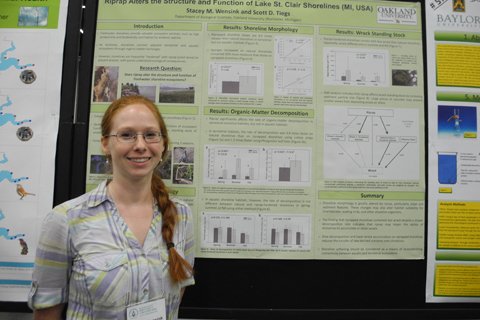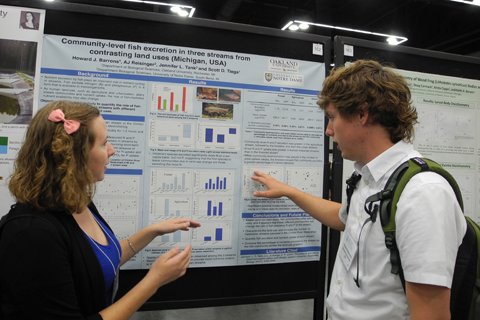Biology students present research at aquatic science conference
 Stacey Wensink presented research on the impact of “riprap” on Lake St. Clair shorelines. She explained that shorelines are frequently "hardened" with riprap (piles of concrete or stone) to prevent erosion and flooding on waterfront properties and that this process can disrupt surrounding ecosystems. |
 Howard Barrons discusses his research presentation with Rachel Voight. Barrons’ presentation was based on a pilot study that involves sampling three streams of contrasting land uses to determine the percentage of nutrients – namely nitrogen and phosphorous – that the fish community provides to the streams. |
Featuring a variety of talks on water-related topics, the meeting focused on exchange of ideas and explored new opportunities for collaboration among aquatic scientists, engineers, students, educators and others. The six Oakland student attendees and presenters – Jeremy Geist, Stacey Wensink, Jacob Riley, Howard Barrons, Rachel Voight and Doug Carmack – conducted their research with guidance from Biology Professor Scott Tiegs.
“They all work so hard in the lab and in the field, and it was fun to see their efforts culminate in quality presentations. Each of them did a great job, had interesting research results to share, and represented OU well,” Dr. Tiegs said.
“In addition to graduate students, we were able to send two undergraduates to the conference – Doug and Rachel. Both are kicking off careers in science, and I think the conference was a great learning and networking experience for them.”
“Part of the reason we were able to send so many students to the meeting is that they were really proactive in getting support from OU in the form of grants such as the Provost’s Award.”
“For a few of the graduate students, the presentations represented several years of work, and it was particularly satisfying to see their efforts come to fruition.”
Benefits of dam removal
During the conference, Geist presented his research on the effects of dam removal on the insect population at Paint Creek in Oakland County.
“Dam removal has great benefits for fish and other aquatic life. However, removing a dam requires some short-term impacts to occur to the stream in order to achieve the long-term benefits that are expected,” Geist explained. “My research during the year after dam removal suggested that the insect community did experience some impact from the project in terms of the number and types of insects making up the community.”
Spearheaded by the Clinton River Watershed Council, removal of the Paint Creek Dam was funded by a $750,000 Environmental Protection Agency grant, roughly $48,000 of which went to support OU research efforts. In addition to pursuing his master’s in biology, Geist works full-time as the CRWC’s watershed ecologist, coordinating water quality sampling efforts and bio-monitoring initiatives, such as the Adopt-A-Stream program. He said the group's collaboration with OU has enriched his research experiences while having a positive effect on the environment.
“Working at CRWC and at OU in the aquatic ecology lab has been very rewarding,” Geist said. “The opportunity has given me the ability to apply my research in a real-world scenario and one that is becoming increasingly common. The project is an example of how collaboration between institutions and organizations can result in a multitude of benefits.”
Negative impact of 'riprap' (concrete or stone on shorelines)
Wensink, also a master’s student in biology, presented research on the impact of “riprap” on Lake St. Clair shorelines. She explained that shorelines are frequently "hardened" with riprap (piles of concrete or stone) to prevent erosion and flooding on waterfront properties and that this process can disrupt surrounding ecosystems.
“We found that hardened shorelines are physically very different from natural shorelines,” Wensink said. “Riprap negatively affected shoreline ecosystem function, particularly in terrestrial areas of shorelines. Organic matter decomposed slowly on riprap-hardened shorelines, and wrack (washed-up organic matter) was less able to accumulate in terrestrial shoreline areas. As a result, riprap appears to reduce nutrient availability and connectivity between the lake and shoreline ecosystems.”
Wensink said the conference provided valuable networking opportunities to advance her educational and career goals.
“Collaboration is important in science, so meeting other scientists who are working on similar research questions is highly beneficial,” she said. “Giving an oral or poster presentation puts your name out for professionals who may be recruiting for careers or graduate school. Also, after putting so much time and effort into your research, it is satisfying to finally share your findings with others who may be able to build off of your work or implement conservation strategies.”
Surveying coastal wetlands in the Great Lakes
Riley echoed those sentiments, calling the conference a “great learning experience.” His presentation examined the fish and invertebrate communities that are found in the St. Marys River, in Sault St. Marie, Michigan.
“My research was an overall look at the types of fish and invertebrates found in these wetlands and the environmental variables – temperate, pH, dissolved oxygen, organic sediments and wind exposure – that helped to shape these communities,” Riley said. “It was part of a larger project funded by the Environmental Protection Agency, called Great Lakes Coastal Wetland Monitoring, which has the goal of surveying every coastal wetland in the Great Lakes.”
Barrons’ presentation was based on a pilot study that involves sampling three streams of contrasting land uses to determine the percentage of nutrients – namely nitrogen and phosphorous – that the fish community provides to the streams. The study also examines “how the surrounding land use affects the role fish play in the provision of nutrients,” Barrons said.
“Presenting my research was a really valuable experience, especially since mine was a pilot project,” he added. “I was able to get a lot of feedback and advice from professionals in the field, and I'll be able to implement some of the suggestions when I do all of my field work this summer.”
For more information on programs and opportunities Oakland’s Department of Biological Sciences, visit the website at oakland.edu/biology. Learn more about OU’s Aquatic Ecology lab at the website.
